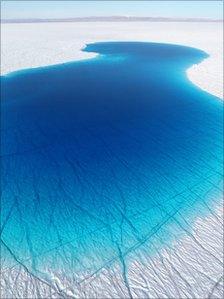Greenland ice sheet future grim, says Aberystwyth study
- Published

Dr Alun Hubbard and his team camped about 70 miles (112km) up the ice sheet in Greenland
A glaciologist is warning that the Greenland ice sheet is "retreating and thinning extensively" after a year of record-breaking high temperatures.
Dr Alun Hubbard of Aberystwyth University says its future is "grim" but disputes claims by other experts that it could collapse within 50 years.
He maintains it would be at least 100 to 1,000 years before it "potentially passes any point of no return leading to any widespread collapse".
Dr Hubbard and his team have been analysing the results of a summer-long expedition.
His team of 15 from Aberystwyth and Swansea universities spent five months on the ice sheet from the beginning of May.
The group camped about 70 miles (112km) up the sheet, and measured the thickness, speed, climate, and other vital statistics using radar, seismic and geophysical equipment.

Large melt lakes form on the Greenland ice sheet
They found rising temperatures had caused extensive melting in new upper parts of the ice sheet in this "very sensitive polar region of the planet".
This has generated at least double the quantity of melt water, compared with 2009, which runs off the ice sheet into the Atlantic and Arctic oceans.
There are fears the melting of the entire sheet could raise sea levels globally by about 7m (20ft), and a study last year found it was losing its mass faster than in previous years.
Dr Hubbard said his expedition had proved enhanced melting was more than just replenishing the oceans, it was now "directly contributing to global sea-level rise".
He said global warming - at least local Greenland warming - was "worse than ever".
"This year was another record-breaking year marked by very warm temperatures across Greenland and the Arctic," he said.
"This warming enhanced and extended melting into new northern and upper parts of the ice sheet generating huge quantities - at least double that compared with the previous year - of melt water which runs off the ice sheet into the ocean."
Dr Hubbard has spent four years researching the effects of climate change on the country. He has also worked on other glaciers and spent five years working in Antarctica before the Greenland project started.
The team of scientists and students monitored the build up and drainage of a series of large melt lakes - up to five miles (8km) across - which form on the ice sheet surface during the summer and can drain rapidly to the bed through more than 1000m of ice.
He said the effect of this rapid drainage was to "lubricate and hydraulically lift up" the base of the ice sheet, "overcoming friction with underlying rock", thereby allowing the sheet to flow much faster.
"It's much like the ice is suddenly aquaplaning or slipping on a banana skin," he explained.
"What we observed using methods borrowed from earthquake monitoring, is that the ice sheet slides and accelerates massively when these lakes drain, but the effect is relatively short lived and that the flow does regulate as further melt water drains to the bed."
His work is part of a wider project involving researchers from Bristol, Cambridge, Edinburgh, Denmark, Sweden, the Netherlands, Germany and the United States.
Dr Hubbard and his team plan to return to the Greenland ice sheet next year to study the effect that reduced winter sea ice has on ice sheet flow and ice berg calving.
Funding for the research has come from the Natural Environment Research Council.